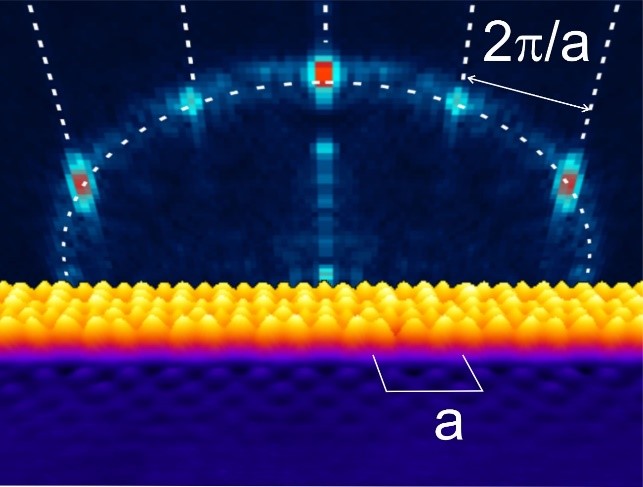Discrete energy levels without confinement – a new quantum trick
06.05.2019
 |
|
A periodic arrangement of organic molecules on a copper surface scatters the electrons in three possible directions in-plane. Image: Alberto Martín. |
Nanostructures can be designed such a way that the quantum confinement allows only certain electron energy levels. Researchers from IMDEA Nanociencia, UAM and ICMM-CSIC have for the first time observed a discrete pattern of electron energies in an unconfined system, which could lead to new ways of modifying the surface properties of materials.
A research group from IMDEA Nanoscience and Universidad Autónoma de Madrid has found for the first time experimental evidence that one-dimensional lattices with nanoscale periodicity can interact with the electrons from a bidimensional gas by spatially separating their different wavelengths by means of a physical phenomenon known as Bragg diffraction. This phenomenon is well known for wave propagation in general and is responsible for the iridescent color observed upon illumination of a CD surface. Due to the wave-particle duality proposed by De Broglie in 1924, electrons also present a wave-like behavior and, thus, diffraction phenomena. Actually, the observation that low-energy free electrons undergo diffraction processes upon interaction with well-ordered atomic lattices on solid surfaces was the first experimental confirmation of the wave-particle duality. Bidimensional electrons bonded to solid surfaces, of course, also present wave-like behavior which could be directly visualized in the 90s by Scanning Tunneling Microscopy. However, the observation of Bragg diffraction in such systems had remained hitherto elusive.
In this new work, featured in the front cover of Physical Review Letters, the group headed by Roberto Otero has built a diffraction grating with nanometer periodicity by self-assembly of organic molecules on a copper surface. The observation, by low-temperature Scanning Tunneling Microscopy, of the stationary waves due to the interference between electrons arriving at the diffraction grating and those reflected by it, allowed the researchers to find experimental evidence for Bragg diffraction. Moreover, the authors have found that their results not only reflect diffraction phenomena, but also that electrons prefer to interact with the lattice such that their incidence direction is reverted. The simultaneous consideration of both effects has led the authors to conclude that a discretization of the energy levels should occur, similar to the one that takes place when the electron’s motion is spatially confined. The discretization of the energy levels upon confinement is one of the main characteristics of Quantum Mechanics, with many applications in Nanoscience and Nanotechnology, and currently allows researchers to control the optical and electronic properties of nanoscale systems. The results in this publication, thus, can open new avenues to fabricate new materials and devices displaying quantum properties without quantum confinement.
Reference:
A. Martín-Jiménez, J. M. Gallego, R. Miranda and R. Otero. Discrete Electronic Subbands due to Bragg Scattering at Molecular Edges. Physical Review Letters 122, 176801 (2019). https://journals.aps.org/prl/abstract/10.1103/PhysRevLett.122.176801
Contacto
Roberto Otero
This email address is being protected from spambots. You need JavaScript enabled to view it.
+34 91 299 88 74
http://www.nanoscience.imdea.org/home-en/people/item/roberto-otero-martin
Twitter: @Roberto80955475
IMDEA Nanociencia Outreach Office
This email address is being protected from spambots. You need JavaScript enabled to view it.
+34 91 299 87 12
Twitter: @imdea_nano
Facebook: @imdeananociencia
Fuente: IMDEA Nanociencia




